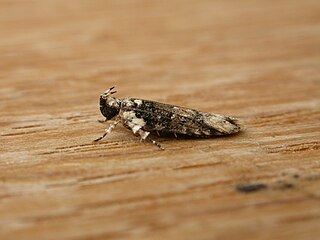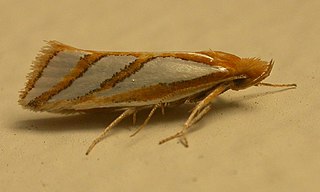Leptogeneia is a genus of moth in the family Gelechiidae. It contains the species Leptogeneia bicristata, which is found in Australia, where it has been recorded from New South Wales.
Jalmenus eubulus is a butterfly of the family Lycaenidae. It is found in the Australian states of New South Wales and Queensland, in the Murray-Darling basin. It was first described in 1876 by William Henry Miskin.

Ardozyga sodalisella is a species of moth in the family Gelechiidae. It was described by Francis Walker in 1864. It is found in Australia, where it has been recorded from Queensland and New South Wales.
Ardozyga subnexella is a species of moth in the family Gelechiidae. It was described by Francis Walker in 1864. It is found in Australia, where it has been recorded from Queensland and New South Wales.
Ardozyga haemaspila is a species of moth in the family Gelechiidae. It was described by Oswald Bertram Lower in 1894. It is found in Australia, where it has been recorded from New South Wales and South Australia.
Bida is a monotypic moth genus in the family Xyloryctidae described by Francis Walker in 1864. Its only species, Bida radiosella, described by the same author one year earlier, is found in Australia, where it has been recorded from New South Wales, South Australia, Tasmania, Victoria and Western Australia.
Lichenaula undulatella is a moth in the family Xyloryctidae. It was described by Francis Walker in 1864. It is found in Australia, where it has been recorded from New South Wales, Queensland and Western Australia.

Thudaca is a moth genus of the family Depressariidae.
Barantola panarista is a moth in the family Depressariidae. It was described by Alfred Jefferis Turner in 1917. It is found in Australia, where it has been recorded from Queensland and New South Wales.
Barantola pulcherrima is a moth in the family Depressariidae. It was described by Francis Walker in 1864. It is found in New Guinea and Australia, where it has been recorded from Queensland and New South Wales.
Peritornenta circulatella is a moth in the family Depressariidae. It was described by Francis Walker in 1864. It is found in Australia, where it has been recorded from the Northern Territory, Queensland and New South Wales.
Thudaca calliphrontis is a moth in the family Depressariidae. It was described by Edward Meyrick in 1893. It is found in Australia, where it has been recorded from South Australia.
Thudaca crypsidesma is a moth in the family Depressariidae. It was described by Edward Meyrick in 1893. It is found in Australia, where it has been recorded from South Australia, Victoria, Tasmania and Western Australia.

Thudaca haplonota is a moth in the family Depressariidae. It was described by Edward Meyrick in 1893. It is found in Australia, where it has been recorded from Western Australia.

Thudaca heterastis is a moth in the family Depressariidae. It was described by Edward Meyrick in 1893. It is found in Australia, where it has been recorded from Western Australia.
Thudaca ophiosema is a moth in the family Depressariidae. It was described by Edward Meyrick in 1893. It is found in Australia, where it has been recorded from Western Australia.
Thudaca orthodroma is a moth in the family Depressariidae. It was described by Edward Meyrick in 1893. It is found in Australia, where it has been recorded from Western Australia.
Thudaca stadiaula is a moth in the family Depressariidae. It was described by Edward Meyrick in 1893. It is found in Australia, where it has been recorded from Western Australia.

Thudaca circumdatella is a moth in the family Depressariidae. It was described by Francis Walker in 1865. It is found in Australia, where it has been recorded from New South Wales.
Antaeotricha filiferella is a moth in the family Depressariidae. It was described by Francis Walker in 1864. It is found in Amazonas in Brazil and in Panama.





